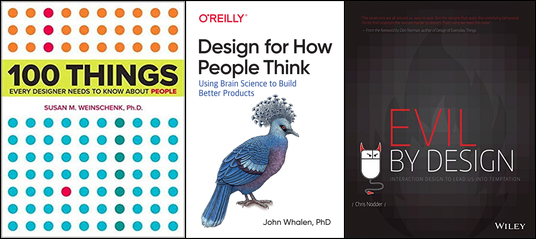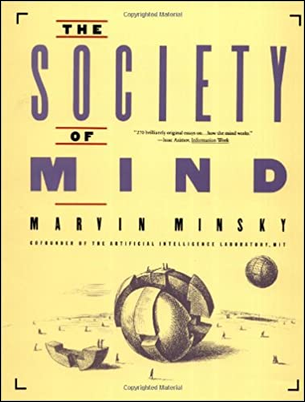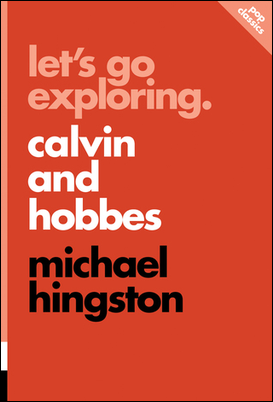
| Read Log, September-October 2020 | |||
| By Tal Cohen | Tuesday, 17 November 2020 | ||
Let’s start with three books about design (mostly software interface, or UX, design):
Design for How People Think: Using Brain Science to Build Better Products by John Whalen. This one is aimed mostly for UX researchers, but is also relevant for designers. The “six minds” model breaks the review of requirements and user feedback into how the human mind works, focusing on language, decision making, wayfinding, vision/attention, memory, and emotion. The first part of the book describes cognitive aspects of each of these “minds”, and how they could affect design choices. The second part shows how they could be used while doing UX research and, to some extent, product design. The third part takes it deeper into product design, focusing on the three goals of appeal (appealing to the audience), enhance (enhancing their lives through your products), and awaken (helping them realize “loftier goals”). This last part was actually the least convincing. Unlike Weinschenk’s 100 Things Every Designer Needs to Know About People, this book does provide a few meaningful insights, although it focuses on a different part of the design process (and when it tries to extend beyond the research phase, it isn’t as successful). Interestingly, the book itself — as a physical object — fails the UX test, with heavy overuse of “sticky note” imagery. When these are merely illustrations, used to make the book longer (as if people are paying for books by their weight), they are probably acceptable. However, when these sticky notes form a key part of the text itself (e.g., some figures in Chapter 8), they fail miserably, with faded, tiny letters that are almost impossible to read. It seems like the text was optimized for e-readers only; the author actually uses “scroll back” where I would expect “turn to the previous page.” Evil by Design: Interaction Design to Lead Us into Temptation by Chris Nodder. Very similar stuff to the last two books, but far more honest, direct, and effective; clearly the best of the three. For example, like Design for How People Think, this book also presents the F-pattern of how people scan a page, but shows how this can be (and is!) abused by designers. The book can be read as a guidebook for evil design, but it’s actually a harsh criticism of common practices (e.g., the privacy settings in Facebook, mocked and ridiculed; or World of Warcraft, where “part of the fun ... is the social aspect of being online with ten million of your closest friends.”) The text is delightfully ironic and fun to read, and also points out at when “evil” design is actually the right thing to do — for example, in nudging people to correctly configure their security settings. And of course, much of these patterns is nothing new; Tom Sawyer, in coercing his friends to paint the fence, or traveling salespeople throughout history, used much of the same tricks. Except now they are used on a much greater scale, and with far higher efficiency. Despite the name, this is a book every designer should read, both for solid advice and for food for thought about what not to do.   Trends in Israeli Poetry in the 1950s — Nationality and Gender: A Reader, edited by Adia Mendelson-Maoz and Mei-Tal Nadler. It’s okay to update the course syllabus; it’s not okay that the textbook and the reader are so out of sync.  So it came to be that a prominent AI researcher published (in 1985) a detailed theory of how minds work; this is what this book is all about. (Of course it wasn’t the first such book by computer scientists.) Minsky presents a detailed theory on the high-level structure of the brain software, or rather, on the mid-level structure, with mapping to actual brain “hardware”. I feel that he maps brain research to computer science way too naïvely (including, for example, diagrams with AND gates), but does present some interesting ideas and directions. Given that we have to start somewhere, this wasn’t necessarily a bad start; however, it seems this didn’t really catch on. Very few of Minsky’s ideas survived and were elaborated on in future research; I haven’t found any later research discussing k-lines, polynemes, or pronomes, for example. His concept of frames is probably the one exception, though I’m not sure how much it’s still used in modern cognitive theories. Although somewhat related, these frames aren’t what software engineers know as stack frames; they’re more like concepts with default values. Such frames and their defaults help us represent the world in a highly efficient manner; we do not have to remember every detail about every object or entity we encounter. On the other hand, a lot of social justice efforts can be framed (no pun intended) in terms of fights to correct these defaults; e.g., why is the default for the concept-frame “doctor” so commonly a white man? This also directly relates to biases in ML models, due to incomplete or biased training datasets. Instead of frames, modern research more commonly uses the term stereotypes (although perhaps it’s not exactly the same), underlining that most stereotypes aren’t bad; if our “stereotype” for, say, a loudspeaker is that it has nothing on its back side except perhaps input jacks, this helps us create a mental model for every new loudspeaker we see, without having to peek at its back. In the decades since the book’s publication, researchers discovered a lot about some of the processes, or “agents”, that form the society of mind; for example, the visual subsystem in the brain constantly examines a simplified (low resolution, blurred, color reduced) input from the eyes, and decides what our vision should focus on at any given moment; this is what controls our constant eye movement. However, to the best of my knowledge, very little progress was made regarding how these agents interact within the brain, or what the software structure is. It seems like concepts and structures Minsky presented, like the investment principle, the non-compromise principle, time-blinking, B-brains, and K-lines are still very much open questions.   
| |||